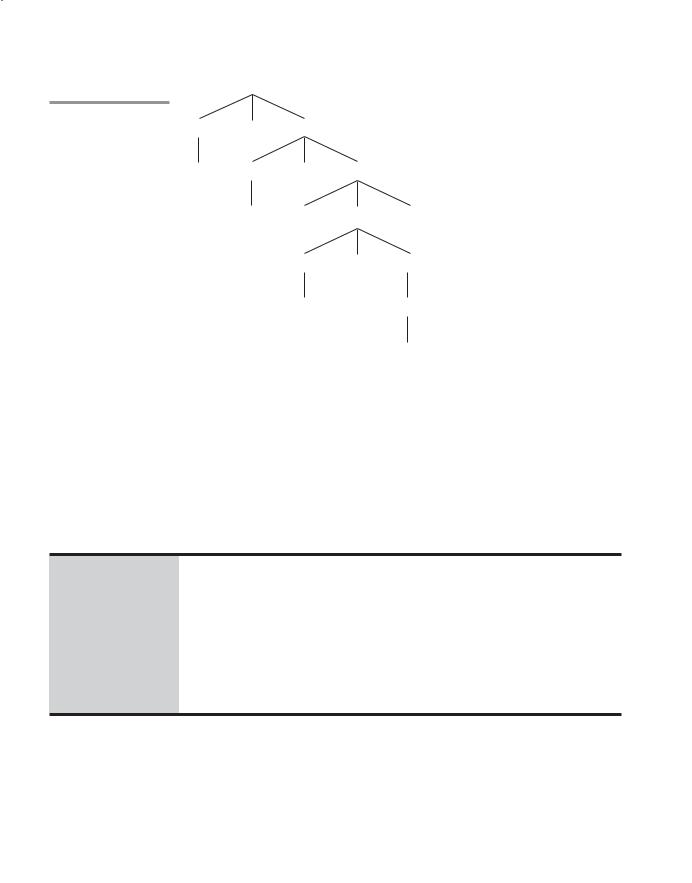
- •New to the Tenth Edition
- •Preface
- •Acknowledgments
- •About the Author
- •Contents
- •1.1 Reasons for Studying Concepts of Programming Languages
- •1.2 Programming Domains
- •1.3 Language Evaluation Criteria
- •1.4 Influences on Language Design
- •1.5 Language Categories
- •1.6 Language Design Trade-Offs
- •1.7 Implementation Methods
- •1.8 Programming Environments
- •Summary
- •Problem Set
- •2.1 Zuse’s Plankalkül
- •2.2 Pseudocodes
- •2.3 The IBM 704 and Fortran
- •2.4 Functional Programming: LISP
- •2.5 The First Step Toward Sophistication: ALGOL 60
- •2.6 Computerizing Business Records: COBOL
- •2.7 The Beginnings of Timesharing: BASIC
- •2.8 Everything for Everybody: PL/I
- •2.9 Two Early Dynamic Languages: APL and SNOBOL
- •2.10 The Beginnings of Data Abstraction: SIMULA 67
- •2.11 Orthogonal Design: ALGOL 68
- •2.12 Some Early Descendants of the ALGOLs
- •2.13 Programming Based on Logic: Prolog
- •2.14 History’s Largest Design Effort: Ada
- •2.15 Object-Oriented Programming: Smalltalk
- •2.16 Combining Imperative and Object-Oriented Features: C++
- •2.17 An Imperative-Based Object-Oriented Language: Java
- •2.18 Scripting Languages
- •2.19 The Flagship .NET Language: C#
- •2.20 Markup/Programming Hybrid Languages
- •Review Questions
- •Problem Set
- •Programming Exercises
- •3.1 Introduction
- •3.2 The General Problem of Describing Syntax
- •3.3 Formal Methods of Describing Syntax
- •3.4 Attribute Grammars
- •3.5 Describing the Meanings of Programs: Dynamic Semantics
- •Bibliographic Notes
- •Problem Set
- •4.1 Introduction
- •4.2 Lexical Analysis
- •4.3 The Parsing Problem
- •4.4 Recursive-Descent Parsing
- •4.5 Bottom-Up Parsing
- •Summary
- •Review Questions
- •Programming Exercises
- •5.1 Introduction
- •5.2 Names
- •5.3 Variables
- •5.4 The Concept of Binding
- •5.5 Scope
- •5.6 Scope and Lifetime
- •5.7 Referencing Environments
- •5.8 Named Constants
- •Review Questions
- •6.1 Introduction
- •6.2 Primitive Data Types
- •6.3 Character String Types
- •6.4 User-Defined Ordinal Types
- •6.5 Array Types
- •6.6 Associative Arrays
- •6.7 Record Types
- •6.8 Tuple Types
- •6.9 List Types
- •6.10 Union Types
- •6.11 Pointer and Reference Types
- •6.12 Type Checking
- •6.13 Strong Typing
- •6.14 Type Equivalence
- •6.15 Theory and Data Types
- •Bibliographic Notes
- •Programming Exercises
- •7.1 Introduction
- •7.2 Arithmetic Expressions
- •7.3 Overloaded Operators
- •7.4 Type Conversions
- •7.5 Relational and Boolean Expressions
- •7.6 Short-Circuit Evaluation
- •7.7 Assignment Statements
- •7.8 Mixed-Mode Assignment
- •Summary
- •Problem Set
- •Programming Exercises
- •8.1 Introduction
- •8.2 Selection Statements
- •8.3 Iterative Statements
- •8.4 Unconditional Branching
- •8.5 Guarded Commands
- •8.6 Conclusions
- •Programming Exercises
- •9.1 Introduction
- •9.2 Fundamentals of Subprograms
- •9.3 Design Issues for Subprograms
- •9.4 Local Referencing Environments
- •9.5 Parameter-Passing Methods
- •9.6 Parameters That Are Subprograms
- •9.7 Calling Subprograms Indirectly
- •9.8 Overloaded Subprograms
- •9.9 Generic Subprograms
- •9.10 Design Issues for Functions
- •9.11 User-Defined Overloaded Operators
- •9.12 Closures
- •9.13 Coroutines
- •Summary
- •Programming Exercises
- •10.1 The General Semantics of Calls and Returns
- •10.2 Implementing “Simple” Subprograms
- •10.3 Implementing Subprograms with Stack-Dynamic Local Variables
- •10.4 Nested Subprograms
- •10.5 Blocks
- •10.6 Implementing Dynamic Scoping
- •Problem Set
- •Programming Exercises
- •11.1 The Concept of Abstraction
- •11.2 Introduction to Data Abstraction
- •11.3 Design Issues for Abstract Data Types
- •11.4 Language Examples
- •11.5 Parameterized Abstract Data Types
- •11.6 Encapsulation Constructs
- •11.7 Naming Encapsulations
- •Summary
- •Review Questions
- •Programming Exercises
- •12.1 Introduction
- •12.2 Object-Oriented Programming
- •12.3 Design Issues for Object-Oriented Languages
- •12.4 Support for Object-Oriented Programming in Smalltalk
- •12.5 Support for Object-Oriented Programming in C++
- •12.6 Support for Object-Oriented Programming in Objective-C
- •12.7 Support for Object-Oriented Programming in Java
- •12.8 Support for Object-Oriented Programming in C#
- •12.9 Support for Object-Oriented Programming in Ada 95
- •12.10 Support for Object-Oriented Programming in Ruby
- •12.11 Implementation of Object-Oriented Constructs
- •Summary
- •Programming Exercises
- •13.1 Introduction
- •13.2 Introduction to Subprogram-Level Concurrency
- •13.3 Semaphores
- •13.4 Monitors
- •13.5 Message Passing
- •13.6 Ada Support for Concurrency
- •13.7 Java Threads
- •13.8 C# Threads
- •13.9 Concurrency in Functional Languages
- •13.10 Statement-Level Concurrency
- •Summary
- •Review Questions
- •Problem Set
- •14.1 Introduction to Exception Handling
- •14.2 Exception Handling in Ada
- •14.3 Exception Handling in C++
- •14.4 Exception Handling in Java
- •14.5 Introduction to Event Handling
- •14.6 Event Handling with Java
- •14.7 Event Handling in C#
- •Review Questions
- •Problem Set
- •15.1 Introduction
- •15.2 Mathematical Functions
- •15.3 Fundamentals of Functional Programming Languages
- •15.4 The First Functional Programming Language: LISP
- •15.5 An Introduction to Scheme
- •15.6 Common LISP
- •15.8 Haskell
- •15.10 Support for Functional Programming in Primarily Imperative Languages
- •15.11 A Comparison of Functional and Imperative Languages
- •Review Questions
- •Problem Set
- •16.1 Introduction
- •16.2 A Brief Introduction to Predicate Calculus
- •16.3 Predicate Calculus and Proving Theorems
- •16.4 An Overview of Logic Programming
- •16.5 The Origins of Prolog
- •16.6 The Basic Elements of Prolog
- •16.7 Deficiencies of Prolog
- •16.8 Applications of Logic Programming
- •Review Questions
- •Programming Exercises
- •Bibliography
- •Index

3.2 The General Problem of Describing Syntax |
115 |
The semantics of this statement form is that when the current value of the Boolean expression is true, the embedded statement is executed. Otherwise, control continues after the while construct. Then control implicitly returns to the Boolean expression to repeat the process.
Although they are often separated for discussion purposes, syntax and semantics are closely related. In a well-designed programming language, semantics should follow directly from syntax; that is, the appearance of a statement should strongly suggest what the statement is meant to accomplish.
Describing syntax is easier than describing semantics, partly because a concise and universally accepted notation is available for syntax description, but none has yet been developed for semantics.
3.2 The General Problem of Describing Syntax
A language, whether natural (such as English) or artificial (such as Java), is a set of strings of characters from some alphabet. The strings of a language are called sentences or statements. The syntax rules of a language specify which strings of characters from the language’s alphabet are in the language. English, for example, has a large and complex collection of rules for specifying the syntax of its sentences. By comparison, even the largest and most complex programming languages are syntactically very simple.
Formal descriptions of the syntax of programming languages, for simplicity’s sake, often do not include descriptions of the lowest-level syntactic units. These small units are called lexemes. The description of lexemes can be given by a lexical specification, which is usually separate from the syntactic description of the language. The lexemes of a programming language include its numeric literals, operators, and special words, among others. One can think of programs as strings of lexemes rather than of characters.
Lexemes are partitioned into groups—for example, the names of variables, methods, classes, and so forth in a programming language form a group called identifiers. Each lexeme group is represented by a name, or token. So, a token of a language is a category of its lexemes. For example, an identifier is a token that can have lexemes, or instances, such as sum and total. In some cases, a token has only a single possible lexeme. For example, the token for the arithmetic operator symbol + has just one possible lexeme. Consider the following Java statement:
index = 2 * count + 17;
The lexemes and tokens of this statement are
Lexemes |
Tokens |
index |
identifier |
= |
equal_sign |
2 |
int_literal |

116Chapter 3 Describing Syntax and Semantics
* mult_op
count |
identifier |
+ |
plus_op |
17 |
int_literal |
; |
semicolon |
The example language descriptions in this chapter are very simple, and most include lexeme descriptions.
3.2.1Language Recognizers
In general, languages can be formally defined in two distinct ways: by recognition and by generation (although neither provides a definition that is practical by itself for people trying to learn or use a programming language). Suppose we have a language L that uses an alphabet of characters. To define L formally using the recognition method, we would need to construct a mechanism R, called a recognition device, capable of reading strings of characters from the alphabet . R would indicate whether a given input string was or was not in L. In effect, R would either accept or reject the given string. Such devices are like filters, separating legal sentences from those that are incorrectly formed. If R, when fed any string of characters over , accepts it only if it is in L, then R is a description of L. Because most useful languages are, for all practical purposes, infinite, this might seem like a lengthy and ineffective process. Recognition devices, however, are not used to enumerate all of the sentences of a language—they have a different purpose.
The syntax analysis part of a compiler is a recognizer for the language the compiler translates. In this role, the recognizer need not test all possible strings of characters from some set to determine whether each is in the language. Rather, it need only determine whether given programs are in the language. In effect then, the syntax analyzer determines whether the given programs are syntactically correct. The structure of syntax analyzers, also known as parsers, is discussed in Chapter 4.
3.2.2Language Generators
A language generator is a device that can be used to generate the sentences of a language. We can think of the generator as having a button that produces a sentence of the language every time it is pushed. Because the particular sentence that is produced by a generator when its button is pushed is unpredictable, a generator seems to be a device of limited usefulness as a language descriptor. However, people prefer certain forms of generators over recognizers because they can more easily read and understand them. By contrast, the syntax-checking portion of a compiler (a language recognizer) is not as useful a language description for a programmer because it can be used only in trial-and-error mode. For example, to determine the correct syntax of a particular statement using a compiler, the programmer can only submit a speculated version and note whether

3.3 Formal Methods of Describing Syntax |
117 |
the compiler accepts it. On the other hand, it is often possible to determine whether the syntax of a particular statement is correct by comparing it with the structure of the generator.
There is a close connection between formal generation and recognition devices for the same language. This was one of the seminal discoveries in computer science, and it led to much of what is now known about formal languages and compiler design theory. We return to the relationship of generators and recognizers in the next section.
3.3 Formal Methods of Describing Syntax
This section discusses the formal language-generation mechanisms, usually called grammars, that are commonly used to describe the syntax of programming languages.
3.3.1Backus-Naur Form and Context-Free Grammars
In the middle to late 1950s, two men, Noam Chomsky and John Backus, in unrelated research efforts, developed the same syntax description formalism, which subsequently became the most widely used method for programming language syntax.
3.3.1.1 Context-Free Grammars
In the mid-1950s, Chomsky, a noted linguist (among other things), described four classes of generative devices or grammars that define four classes of languages (Chomsky, 1956, 1959). Two of these grammar classes, named context-free and regular, turned out to be useful for describing the syntax of programming languages. The forms of the tokens of programming languages can be described by regular grammars. The syntax of whole programming languages, with minor exceptions, can be described by context-free grammars. Because Chomsky was a linguist, his primary interest was the theoretical nature of natural languages. He had no interest at the time in the artificial languages used to communicate with computers. So it was not until later that his work was applied to programming languages.
3.3.1.2 Origins of Backus-Naur Form
Shortly after Chomsky’s work on language classes, the ACM-GAMM group began designing ALGOL 58. A landmark paper describing ALGOL 58 was presented by John Backus, a prominent member of the ACM-GAMM group, at an international conference in 1959 (Backus, 1959). This paper introduced a new formal notation for specifying programming language syntax. The new notation was later modified slightly by Peter Naur for the description of

118 |
Chapter 3 Describing Syntax and Semantics |
ALGOL 60 (Naur, 1960). This revised method of syntax description became known as Backus-Naur Form, or simply BNF.
BNF is a natural notation for describing syntax. In fact, something similar to BNF was used by Panini to describe the syntax of Sanskrit several hundred years before Christ (Ingerman, 1967).
Although the use of BNF in the ALGOL 60 report was not immediately accepted by computer users, it soon became and is still the most popular method of concisely describing programming language syntax.
It is remarkable that BNF is nearly identical to Chomsky’s generative devices for context-free languages, called context-free grammars. In the remainder of the chapter, we refer to context-free grammars simply as grammars. Furthermore, the terms BNF and grammar are used interchangeably.
3.3.1.3 Fundamentals
A metalanguage is a language that is used to describe another language. BNF is a metalanguage for programming languages.
BNF uses abstractions for syntactic structures. A simple Java assignment statement, for example, might be represented by the abstraction <assign> (pointed brackets are often used to delimit names of abstractions). The actual definition of <assign> can be given by
<assign> → <var> = <expression>
The text on the left side of the arrow, which is aptly called the left-hand side (LHS), is the abstraction being defined. The text to the right of the arrow is the definition of the LHS. It is called the right-hand side (RHS) and consists of some mixture of tokens, lexemes, and references to other abstractions. (Actually, tokens are also abstractions.) Altogether, the definition is called a rule, or production. In the example rule just given, the abstractions <var> and <expression> obviously must be defined for the <assign> definition to be useful.
This particular rule specifies that the abstraction <assign> is defined as an instance of the abstraction <var>, followed by the lexeme =, followed by an instance of the abstraction <expression>. One example sentence whose syntactic structure is described by the rule is
total = subtotal1 + subtotal2
The abstractions in a BNF description, or grammar, are often called nonterminal symbols, or simply nonterminals, and the lexemes and tokens of the rules are called terminal symbols, or simply terminals. A BNF description, or grammar, is a collection of rules.
Nonterminal symbols can have two or more distinct definitions, representing two or more possible syntactic forms in the language. Multiple definitions can be written as a single rule, with the different definitions separated by

3.3 Formal Methods of Describing Syntax |
119 |
the symbol|, meaning logical OR. For example, a Java if statement can be described with the rules
<if_stmt> → if ( <logic_expr> ) <stmt>
<if_stmt> → if ( <logic_expr> ) <stmt> else <stmt>
or with the rule
<if_stmt> → if ( <logic_expr> ) <stmt>
| if ( <logic_expr> ) <stmt> else <stmt>
In these rules, <stmt> represents either a single statement or a compound statement.
Although BNF is simple, it is sufficiently powerful to describe nearly all of the syntax of programming languages. In particular, it can describe lists of similar constructs, the order in which different constructs must appear, and nested structures to any depth, and even imply operator precedence and operator associativity.
3.3.1.4 Describing Lists
Variable-length lists in mathematics are often written using an ellipsis (. . .); 1, 2, . . . is an example. BNF does not include the ellipsis, so an alternative method is required for describing lists of syntactic elements in programming languages (for example, a list of identifiers appearing on a data declaration statement). For BNF, the alternative is recursion. A rule is recursive if its LHS appears in its RHS. The following rules illustrate how recursion is used to describe lists:
<ident_list> → identifier
| identifier, <ident_list>
This defines <ident_list> as either a single token (identifier) or an identifier followed by a comma and another instance of <ident_list>. Recursion is used to describe lists in many of the example grammars in the remainder of this chapter.
3.3.1.5 Grammars and Derivations
A grammar is a generative device for defining languages. The sentences of the language are generated through a sequence of applications of the rules, beginning with a special nonterminal of the grammar called the start symbol. This sequence of rule applications is called a derivation. In a grammar for a complete programming language, the start symbol represents a complete program and is often named <program>. The simple grammar shown in Example 3.1 is used to illustrate derivations.

120 |
Chapter 3 Describing Syntax and Semantics |
EXAMPLE 3.1 A Grammar for a Small Language
<program> → begin <stmt_list> end
<stmt_list> → <stmt>
| <stmt> ; <stmt_list> <stmt> → <var> = <expression> <var> → A | B | C
<expression> → <var> + <var> | <var> – <var> | <var>
The language described by the grammar of Example 3.1 has only one statement form: assignment. A program consists of the special word begin, followed by a list of statements separated by semicolons, followed by the special word end. An expression is either a single variable or two variables separated by either a + or - operator. The only variable names in this language are A, B, and C.
A derivation of a program in this language follows:
<program> => begin <stmt_list> end
=> begin <stmt> ; <stmt_list> end
=> begin <var> = <expression> ; <stmt_list> end => begin A = <expression> ; <stmt_list> end
=> begin A = <var> + <var> ; <stmt_list> end => begin A = B + <var> ; <stmt_list> end => begin A = B + C ; <stmt_list> end
=> begin A = B + C ; <stmt> end
=> begin A = B + C ; <var> = <expression> end => begin A = B + C ; B = <expression> end
=> begin A = B + C ; B = <var> end
=> begin A = B + C ; B = C end
This derivation, like all derivations, begins with the start symbol, in this case <program>. The symbol => is read “derives.” Each successive string in the sequence is derived from the previous string by replacing one of the nonterminals with one of that nonterminal’s definitions. Each of the strings in the derivation, including <program>, is called a sentential form.
In this derivation, the replaced nonterminal is always the leftmost nonterminal in the previous sentential form. Derivations that use this order of replacement are called leftmost derivations. The derivation continues until the sentential form contains no nonterminals. That sentential form, consisting of only terminals, or lexemes, is the generated sentence.

3.3 Formal Methods of Describing Syntax |
121 |
In addition to leftmost, a derivation may be rightmost or in an order that is neither leftmost nor rightmost. Derivation order has no effect on the language generated by a grammar.
By choosing alternative RHSs of rules with which to replace nonterminals in the derivation, different sentences in the language can be generated. By exhaustively choosing all combinations of choices, the entire language can be generated. This language, like most others, is infinite, so one cannot generate all the sentences in the language in finite time.
Example 3.2 is another example of a grammar for part of a typical programming language.
EXAMPLE 3.2 A Grammar for Simple Assignment Statements
<assign> → <id> = <expr> <id> → A | B | C
<expr> → <id> + <expr> | <id> * <expr> | ( <expr> )
| <id>
The grammar of Example 3.2 describes assignment statements whose right sides are arithmetic expressions with multiplication and addition operators and parentheses. For example, the statement
A = B * ( A + C )
is generated by the leftmost derivation:
<assign> => <id> = <expr> => A = <expr>
=> A = <id> * <expr>
=> A = B * <expr>
=> A = B * ( <expr> )
=> A = B * ( <id> + <expr> ) => A = B * ( A + <expr> ) => A = B * ( A + <id> ) => A = B * ( A + C )
3.3.1.6 Parse Trees
One of the most attractive features of grammars is that they naturally describe the hierarchical syntactic structure of the sentences of the languages they define. These hierarchical structures are called parse trees. For example, the parse tree in Figure 3.1 shows the structure of the assignment statement derived previously.

122 |
Chapter 3 |
Figure 3.1
A parse tree for the simple statement
A = B * (A + C)
Describing Syntax and Semantics
|
<assign> |
|
|
|
<id> |
= |
<expr> |
|
|
A |
<id> |
* |
<expr> |
|
|
B |
( |
<expr> |
) |
|
|
<id> |
+ |
<expr> |
|
|
A |
|
<id> |
|
|
|
|
C |
Every internal node of a parse tree is labeled with a nonterminal symbol; every leaf is labeled with a terminal symbol. Every subtree of a parse tree describes one instance of an abstraction in the sentence.
3.3.1.7 Ambiguity
A grammar that generates a sentential form for which there are two or more distinct parse trees is said to be ambiguous. Consider the grammar shown in Example 3.3, which is a minor variation of the grammar shown in Example 3.2.
EXAMPLE 3.3 An Ambiguous Grammar for Simple Assignment Statements
<assign> → <id> = <expr> <id> → A | B | C
<expr> → <expr> + <expr> | <expr> * <expr> | ( <expr> )
| <id>
The grammar of Example 3.3 is ambiguous because the sentence
A = B + C * A
has two distinct parse trees, as shown in Figure 3.2. The ambiguity occurs because the grammar specifies slightly less syntactic structure than does the grammar of

Figure 3.2
Two distinct parse trees for the same sentence,
A = B + C * A
3.3 Formal Methods of Describing Syntax |
123 |
Example 3.2. Rather than allowing the parse tree of an expression to grow only on the right, this grammar allows growth on both the left and the right.
|
<assign> |
|
|
|
|
<assign> |
|
|
|
<id> |
= |
<expr> |
|
|
<id> |
= |
<expr> |
|
|
A |
<expr> |
+ |
<expr> |
|
A |
<expr> |
* |
<expr> |
|
|
|
|
* |
|
|
+ |
|
|
|
|
|
|
|
|
|
|
|
||
|
<id> |
<expr> |
<expr> |
<expr> |
<expr> |
<id> |
|||
|
|
|
|
|
|
|
|
|
|
|
|
|
|
|
|
|
|
|
|
|
B |
<id> |
|
<id> |
<id> |
|
<id> |
A |
|
|
|
C |
|
A |
B |
|
C |
|
|
Syntactic ambiguity of language structures is a problem because compilers often base the semantics of those structures on their syntactic form. Specifically, the compiler chooses the code to be generated for a statement by examining its parse tree. If a language structure has more than one parse tree, then the meaning of the structure cannot be determined uniquely. This problem is discussed in two specific examples in the following subsections.
There are several other characteristics of a grammar that are sometimes useful in determining whether a grammar is ambiguous.1 They include the following: (1) if the grammar generates a sentence with more than one leftmost derivation and (2) if the grammar generates a sentence with more than one rightmost derivation.
Some parsing algorithms can be based on ambiguous grammars. When such a parser encounters an ambiguous construct, it uses nongrammatical information provided by the designer to construct the correct parse tree. In many cases, an ambiguous grammar can be rewritten to be unambiguous but still generate the desired language.
3.3.1.8 Operator Precedence
When an expression includes two different operators, for example, x + y * z, one obvious semantic issue is the order of evaluation of the two operators (for example, in this expression is it add and then multiply, or vice versa?). This semantic question can be answered by assigning different precedence levels to operators. For example, if * has been assigned higher precedence than + (by the language
1.Note that it is mathematically impossible to determine whether an arbitrary grammar is ambiguous.

124 |
Chapter 3 Describing Syntax and Semantics |
designer), multiplication will be done first, regardless of the order of appearance of the two operators in the expression.
As stated previously, a grammar can describe a certain syntactic structure so that part of the meaning of the structure can be determined from its parse tree. In particular, the fact that an operator in an arithmetic expression is generated lower in the parse tree (and therefore must be evaluated first) can be used to indicate that it has precedence over an operator produced higher up in the tree. In the first parse tree of Figure 3.2, for example, the multiplication operator is generated lower in the tree, which could indicate that it has precedence over the addition operator in the expression. The second parse tree, however, indicates just the opposite. It appears, therefore, that the two parse trees indicate conflicting precedence information.
Notice that although the grammar of Example 3.2 is not ambiguous, the precedence order of its operators is not the usual one. In this grammar, a parse tree of a sentence with multiple operators, regardless of the particular operators involved, has the rightmost operator in the expression at the lowest point in the parse tree, with the other operators in the tree moving progressively higher as one moves to the left in the expression. For example, in the expression A + B * C, * is the lowest in the tree, indicating it is to be done first. However, in the expression A * B + C, + is the lowest, indicating it is to be done first.
A grammar can be written for the simple expressions we have been discussing that is both unambiguous and specifies a consistent precedence of the + and * operators, regardless of the order in which the operators appear in an expression. The correct ordering is specified by using separate nonterminal symbols to represent the operands of the operators that have different precedence. This requires additional nonterminals and some new rules. Instead of using <expr> for both operands of both + and *, we could use three nonterminals to represent operands, which allows the grammar to force different operators to different levels in the parse tree. If <expr> is the root symbol for expressions, + can be forced to the top of the parse tree by having <expr> directly generate only + operators, using the new nonterminal, <term>, as the right operand of +. Next, we can define <term> to generate * operators, using <term> as the left operand and a new nonterminal, <factor>, as its right operand. Now, * will always be lower in the parse tree, simply because it is farther from the start symbol than + in every derivation. The grammar of Example 3.4 is such a grammar.

3.3 Formal Methods of Describing Syntax |
125 |
EXAMPLE 3.4 |
|
An Unambiguous Grammar for Expressions |
||
|
|
<assign> → <id> = <expr> |
|
|
|
|
<id> → A | B | C |
|
|
|
|
<expr> → <expr> |
+ <term> |
|
|
|
| <term> |
|
|
|
|
<term> → <term> |
* <factor> |
|
|
|
| <factor> |
|
|
|
|
<factor> → ( <expr> ) |
|
|
|
|
| <id> |
|
|
|
|
|
||
|
|
The grammar in Example 3.4 generates the same language as the grammars of |
||
|
|
Examples 3.2 and 3.3, but it is unambiguous and it specifies the usual prece- |
||
|
|
dence order of multiplication and addition operators. The following derivation |
||
|
|
of the sentence A = B + C * A uses the grammar of Example 3.4: |
||
|
|
<assign> => <id> |
= <expr> |
|
|
|
=> A = <expr> |
|
|
|
|
=> A = <expr> + <term> |
||
|
|
=> A = <term> + <term> |
||
|
|
=> A = <factor> + <term> |
||
|
|
=> A = <id> + <term> |
||
|
|
=> A = B + <term> |
|
|
|
|
=> A = B + <term> |
* <factor> |
|
|
|
=> A = B + <factor> |
* <factor> |
|
|
|
=> A = B + <id> * <factor> |
||
=> A = B + C * <factor> => A = B + C * <id>
=> A = B + C * A
The unique parse tree for this sentence, using the grammar of Example 3.4, is shown in Figure 3.3.
The connection between parse trees and derivations is very close: Either can easily be constructed from the other. Every derivation with an unambiguous grammar has a unique parse tree, although that tree can be represented by different derivations. For example, the following derivation of the sentence A = B + C * A is different from the derivation of the same sentence given previously. This is a rightmost derivation, whereas the previous one is leftmost. Both of these derivations, however, are represented by the same parse tree.

126 |
Chapter 3 Describing Syntax and Semantics |
|
|
|
<assign> => <id> |
= <expr> |
|
|
=> <id> |
= <expr> |
+ <term> |
|
=> <id> |
= <expr> |
+ <term> * <factor> |
|
=> <id> |
= <expr> |
+ <term> * <id> |
|
=> <id> |
= <expr> |
+ <term> * A |
|
=> <id> |
= <expr> |
+ <factor> * A |
|
=> <id> |
= <expr> |
+ <id> * A |
|
=> <id> |
= <expr> + C * A |
|
|
=> <id> |
= <term> + C * A |
|
|
=> <id> |
= <factor> + C * A |
|
|
=> <id> |
= <id> + C * A |
|
|
=> <id> |
= B + C * A |
|
|
=> A = B + C * A |
||
Figure 3.3
The unique parse tree for A = B + C * A using an unambiguous grammar
|
<assign> |
|
|
|
<id> |
= |
<expr> |
|
|
A |
<expr> |
+ |
<term> |
|
|
<term> |
<term> |
* |
<factor> |
|
<factor> |
<factor> |
|
<id> |
|
<id> |
<id> |
|
A |
BC
3.3.1.9Associativity of Operators
When an expression includes two operators that have the same precedence (as * and / usually have)—for example, A / B * C—a semantic rule is required to specify which should have precedence.2 This rule is named associativity.
2.An expression with two occurrences of the same operator has the same issue; for example,
A / B / C.

3.3 Formal Methods of Describing Syntax |
127 |
As was the case with precedence, a grammar for expressions may correctly imply operator associativity. Consider the following example of an assignment statement:
A = B + C + A
The parse tree for this sentence, as defined with the grammar of Example 3.4, is shown in Figure 3.4.
The parse tree of Figure 3.4 shows the left addition operator lower than the right addition operator. This is the correct order if addition is meant to be left associative, which is typical. In most cases, the associativity of addition in a computer is irrelevant. In mathematics, addition is associative, which means that left and right associative orders of evaluation mean the same thing. That is, (A + B) + C = A + (B + C). Floating-point addition in a computer, however, is not necessarily associative. For example, suppose floating-point values store seven digits of accuracy. Consider the problem of adding 11 numbers together, where one of the numbers is 107 and the other ten are 1. If the small numbers (the 1’s) are each added to the large number, one at a time, there is no effect on that number, because the small numbers occur in the eighth digit of the large number. However, if the small numbers are first added together and the result is added to the large number, the result in seven-digit accuracy is 1.000001 * 107. Subtraction and division are not associative, whether in mathematics or in a computer. Therefore, correct associativity may be essential for an expression that contains either of them.
Figure 3.4 |
|
|
<assign> |
|
|
|
|
|
|
|
|
|
|
|
|
A parse tree for A = B |
<id> |
= |
<expr> |
|
|
||
+ C + A illustrating |
|
|
|||||
|
|
|
|
|
|
|
|
the associativity of |
|
|
|
|
|
|
|
addition |
A |
<expr> |
+ |
<term> |
|||
|
|||||||
|
<expr> |
+ |
<term> |
<factor> |
|||
|
|
|
|
|
|
|
|
|
|
|
|
|
|
|
|
|
<term> |
|
<factor> |
<id> |
|||
|
|
|
|
|
|
|
|
|
<factor> |
|
<id> |
A |
|||
|
|
|
|
|
|
|
|
|
<id> |
|
C |
|
|
||
B

128 |
Chapter 3 Describing Syntax and Semantics |
When a grammar rule has its LHS also appearing at the beginning of its RHS, the rule is said to be left recursive. This left recursion specifies left associativity. For example, the left recursion of the rules of the grammar of Example 3.4 causes it to make both addition and multiplication left associative. Unfortunately, left recursion disallows the use of some important syntax analysis algorithms. When such algorithms are to be used, the grammar must be modified to remove the left recursion. This, in turn, disallows the grammar from precisely specifying that certain operators are left associative. Fortunately, left associativity can be enforced by the compiler, even though the grammar does not dictate it.
In most languages that provide it, the exponentiation operator is right associative. To indicate right associativity, right recursion can be used. A grammar rule is right recursive if the LHS appears at the right end of the RHS. Rules such as
<factor> → <exp> ** <factor> |<exp>
<exp> → ( <expr> ) |id
could be used to describe exponentiation as a right-associative operator.
3.3.1.10 An Unambiguous Grammar for if-then-else
The BNF rules for an Ada if-then-else statement are as follows:
<if_stmt> → if <logic_expr> then <stmt>
if <logic_expr> then <stmt> else <stmt>
If we also have <stmt> → <if_stmt>, this grammar is ambiguous. The simplest sentential form that illustrates this ambiguity is
if <logic_expr> then if <logic_expr> then <stmt> else <stmt>
The two parse trees in Figure 3.5 show the ambiguity of this sentential form. Consider the following example of this construct:
if done == true
then if denom == 0
then quotient = 0;
else quotient = num / denom;
The problem is that if the upper parse tree in Figure 3.5 is used as the basis for translation, the else clause would be executed when done is not true, which probably is not what was intended by the author of the construct. We will examine the practical problems associated with this else-association problem in Chapter 8.
We will now develop an unambiguous grammar that describes this if statement. The rule for if constructs in many languages is that an else clause, when present, is matched with the nearest previous unmatched then.

3.3 Formal Methods of Describing Syntax |
129 |
Figure 3.5 |
<if_stmt> |
Two distinct parse trees for the same sentential form
if <logic_expr> |
then <stmt> else <stmt> |
|
<if_stmt> |
if |
<logic_expr> then <stmt> |
<if_stmt> |
|
if <logic_expr> then <stmt>
<if_stmt>
if <logic_expr> then <stmt> else <stmt>
Therefore, there cannot be an if statement without an else between a then and its matching else. So, for this situation, statements must be distinguished between those that are matched and those that are unmatched, where unmatched statements are else-less ifs and all other statements are matched. The problem with the earlier grammar is that it treats all statements as if they had equal syntactic significance—that is, as if they were all matched.
To reflect the different categories of statements, different abstractions, or nonterminals, must be used. The unambiguous grammar based on these ideas follows:
<stmt> → <matched> | <unmatched>
<matched> → if <logic_expr> then <matched> else <matched> |any non-if statement
<unmatched> → if <logic_expr> then <stmt>
|if <logic_expr> then <matched> else <unmatched>
There is just one possible parse tree, using this grammar, for the following sentential form:
if <logic_expr> then if <logic_expr> then <stmt> else <stmt>

130 Chapter 3 Describing Syntax and Semantics
3.3.2 Extended BNF
Because of a few minor inconveniences in BNF, it has been extended in several ways. Most extended versions are called Extended BNF, or simply EBNF, even though they are not all exactly the same. The extensions do not enhance the descriptive power of BNF; they only increase its readability and writability.
Three extensions are commonly included in the various versions of EBNF. The first of these denotes an optional part of an RHS, which is delimited by brackets. For example, a C if-else statement can be described as
<if_stmt> → if (<expression>) <statement> [else <statement>]
Without the use of the brackets, the syntactic description of this statement would require the following two rules:
<if_stmt> → if (<expression>) <statement>
| if (<expression>) <statement> else <statement>
The second extension is the use of braces in an RHS to indicate that the enclosed part can be repeated indefinitely or left out altogether. This extension allows lists to be built with a single rule, instead of using recursion and two rules. For example, lists of identifiers separated by commas can be described by the following rule:
<ident_list> → <identifier> {, <identifier>}
This is a replacement of the recursion by a form of implied iteration; the part enclosed within braces can be iterated any number of times.
The third common extension deals with multiple-choice options. When a single element must be chosen from a group, the options are placed in parentheses and separated by the OR operator, |. For example,
<term> → <term> (* | / | %) <factor>
In BNF, a description of this <term> would require the following three rules:
<term> → <term> * <factor> | <term> / <factor> | <term> % <factor>
The brackets, braces, and parentheses in the EBNF extensions are metasymbols, which means they are notational tools and not terminal symbols in the syntactic entities they help describe. In cases where these metasymbols are also terminal symbols in the language being described, the instances that are terminal symbols can be underlined or quoted. Example 3.5 illustrates the use of braces and multiple choices in an EBNF grammar.

3.3 Formal Methods of Describing Syntax |
131 |
EXAMPLE 3.5 BNF and EBNF Versions of an Expression Grammar
BNF:
<expr> → <expr> + <term> | <expr> - <term> | <term>
<term> → <term> * <factor> | <term> / <factor> | <factor>
<factor> → <exp> ** <factor> <exp>
<exp> → (<expr>) | id
EBNF:
<expr> → <term> {(+ | -) <term>} <term> → <factor> {(* | /) <factor>} <factor> → <exp> { ** <exp>}
<exp> → (<expr>) | id
The BNF rule
<expr> → <expr> + <term>
clearly specifies—in fact forces—the + operator to be left associative. However, the EBNF version,
<expr> → <term> {+ <term>}
does not imply the direction of associativity. This problem is overcome in a syntax analyzer based on an EBNF grammar for expressions by designing the syntax analysis process to enforce the correct associativity. This is further discussed in Chapter 4.
Some versions of EBNF allow a numeric superscript to be attached to the right brace to indicate an upper limit to the number of times the enclosed part can be repeated. Also, some versions use a plus (+) superscript to indicate one or more repetitions. For example,
<compound> → begin <stmt> {<stmt>} end and
<compound> → begin {<stmt>}+ end are equivalent.
